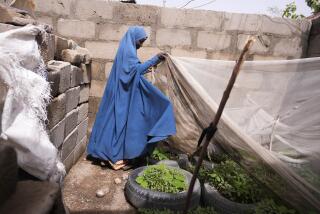To curb global hunger, think insects and seaweed
In a powerful piece about global hunger, Kenneth R. Weiss shows readers the landscape in Dadaab, Kenya, where people are suffering and dying from chronic undernourishment and hunger-related conditions.
In this third installment of a five-part series about the global population explosion, Weiss writes: “Across Africa and in parts of South Asia and Latin America, hundreds of millions of people live on the edge of starvation. A drought, flood or outbreak of violence can push them over the brink.”
It’s an especially cruel fate when you consider that, “on paper,” the world’s farmers produce enough food to go around. “People go hungry in developing countries because they can’t afford to buy food and can’t grow enough on their own,” writes Weiss of the issue also plaguing parts of South Asia and Latin America. “Inadequate transportation and storage aggravate shortages.”
And then there are the environmental issues, among them land that’s no longer able to produce crops, climate concerns over cultivating new land, and severe droughts in parts of the world that punish its inhabitants in a variety of ways, including killing its livestock and preventing crops from growing.
SPECIAL REPORT: Beyond 7 billion
“Major international research projects are underway to develop hybrid crops to withstand these challenges. But such efforts take decades, and there is no guarantee of success,” writes Weiss.
There are other solutions, of course, that should be employed simultaneously. I listed a few ideas last summer after U.N. Secretary-General Ban Ki-moon wrote a plea in our pages, “We can’t allow Somalia to starve.” Some of the ideas included fostering peace and stability, and establishing a government that cares about basic human rights.
Here’s a new one I came across this summer: broadening our appetite. In an article for Slate, Josh Schonwald wrote: “Much of the conversation about how to solve the coming food crisis caused by soaring population, diminishing resources, and a warming planet focuses rightly on technology, reducing waste, and improving food access and distribution methods. But equal urgency needs to be devoted to simply broadening our appetites. Two food sources that strike many as unpalatable -- insects and seaweed -- could play a critical role in not only feeding the 2.5 billion extra humans expected by 2050, but doing so in a green, climate-friendly way.”
PHOTOS: Hunger leaves parts of Africa in misery
Lobsters were once a gross-out food, he reminds, saying that the same could one day be true of insects. Ditto seaweed, which is rich in nutrients and, among macrobiotic eaters at least, the ultimate superfood. Says Schonwald: “Oceans are the slackers of food production -- they cover more than 70 percent of the Earth’s surface, yet yield 2 percent of our food. Two percent. And it’s not because we haven’t done a good job catching or growing fish.”
ALSO:
Is medical marijuana good medicine?
Should the media not use James Holmes’ name?
Follow Alexandra Le Tellier on Twitter @alexletellier. Follow Opinion L.A. on Twitter and Facebook.
More to Read
A cure for the common opinion
Get thought-provoking perspectives with our weekly newsletter.
You may occasionally receive promotional content from the Los Angeles Times.










